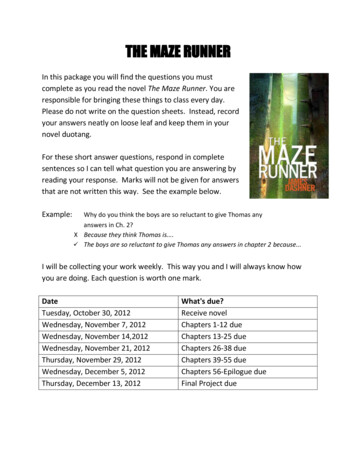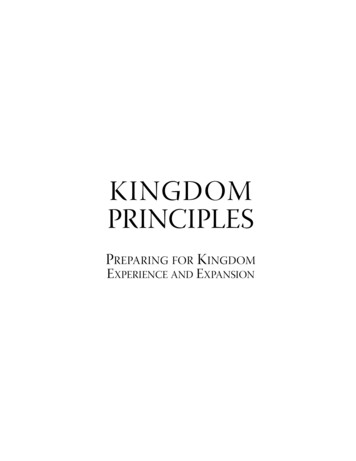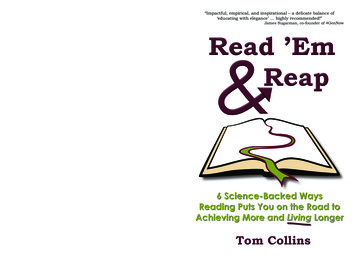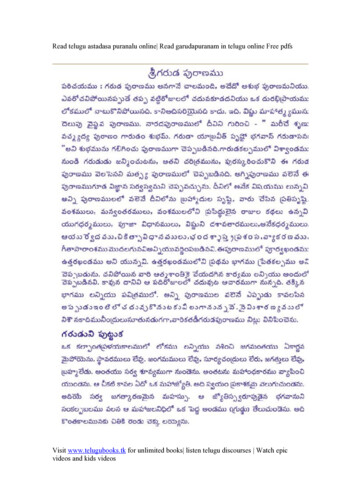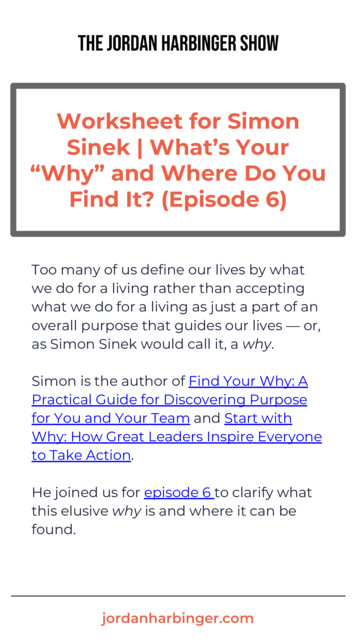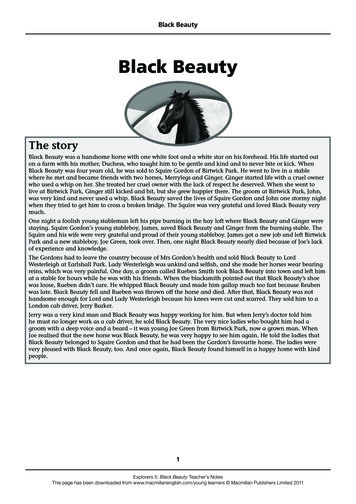
Transcription
Why Should We Read and Discussthe Book of Isaiah?Anyone who really wants to understand the Bible in depth has to engagethe book of Isaiah. In sheer volume of material alone, Isaiah makes up asubstantial portion of the Scriptures. It’s as long as all of Paul’s letters combined. Even more significantly, many vital truths about God are disclosed forthe first time in the book—truths about who God is and about what God’splans are for the redemption of humanity and all of creation. As a result,Isaiah is one of the most influential books within the rest of the Bible. TheNew Testament writers quote from it more often than from any other book.Beyond all this, it has also exerted a strong cultural influence beyond theBible. It’s the source of popular metaphors and sayings, such as the idea of“beating swords into plowshares,” and “the wolf lying down with the lamb,”and it has inspired artworks and musical compositions down through thecenturies, such as Edward Hicks’ paintings of The Peaceable Kingdom andmuch of Handel’s oratorio Messiah. So this is simply an indispensable bookto engage and appreciate.At the same time, however, Isaiah is one of the most difficult books in theBible to understand. There are a number of reasons for this. For one thing, it’s unique among the biblical books in that itwas occasioned by two different crises in the life of the nationof Israel, 150 years apart. In addition to addressing thesecrises, it also looks farther ahead to God’s ultimate purposes inthe world. For another thing, the major sections of the book aren’t inIsaiah UBB.indd 110/2/12 12:42 PM
chronological sequence. Rather, they oscillate back and forthbetween these two periods. (See the chart on page 10.) Even within sections that speak to a given period, the materialsaren’t arranged the way they would be in the works we knowtoday. They’re not in a logical or thematic progression. Instead,there’s sharp alteration between different moods, themes,and messages. Finally, most of the book consists of prophetic oracles, a particular kind of poetry or song that has no real equivalent todayand which is unfamiliar to most readers as a result.For all of these reasons, anyone who tries to read straight through thebook of Isaiah will likely become lost and confused, and potentially prettyfrustrated as well. The grandeur of many of the passages keeps readers going,hoping for more (and they find it), but they often get no understanding ofthe book as a whole.To overcome these difficulties and help readers understand and appreciate this vital work within the Scriptures, this study guide will take a differentapproach. The book of Isaiah is essentially a collection of poems, songs, andstories. They were put together, for reasons that will become clear in thesessions ahead, in an order we would not expect today. But as in the caseof any biblical book that is a collection of independent compositions (likePsalms), rather than a single composition itself (like Esther), it’s necessary firstto understand the parts, and then understand the whole from the parts, ratherthan working in the opposite direction.To help today’s readers do this, this guide will take up the materials withinIsaiah in a different order from the one in which they appear in the book. Itwill take up the passages in the book in their historical order, explainingtheir historical contexts, so that readers can ultimately also appreciate theirliterary contexts—that is, their placement in a particular location within theentire collection.The book of Isaiah is a bit like the kind of trophy case you’d find in thefront hallway of a school. The trophies, awards, and plaques in these casesusually aren’t arranged in historical order, from left to right. Instead, the tallest trophy will likely be in the middle, with shorter trophies on each side, andeven shorter ones towards the edges of the case—regardless of when they wereIsaiah UBB.indd 210/2/12 12:42 PM
won. Photos and plaques will be hung on the back wall where there is spaceand visibility, but not necessarily right behind trophies from the same era. Theoverall goal is to create a pleasing and appealing visual arrangement. In thesame way, the poems, stories, and songs in the book of Isaiah are arranged nothistorically but artistically. Prophetic responses to significant challenges thatthe people of God faced at different times are blended together into an overallmessage. This study guide will help you appreciate this arrangement, engagethe materials within it, and so grasp the message of this giant, influentialbook within the Bible. Isaiah will always be a difficult book to understand,and it will require effort and perseverance to work through this guide. But ifyou’re up for a challenge that will pay very rich rewards, and particularly ifyou’re familiar with the format of these guides from using other titles in theseries, then come aboard for a tour of the vast, fascinating landscape of thismonumental inspired work.Isaiah UBB.indd 310/2/12 12:42 PM
Isaiah UBB.indd 410/2/12 12:42 PM
Understanding theBooks of the BibleIsaiahIsaiah UBB.indd 510/2/12 12:42 PM
Also available in theUnderstanding the Books of the Bible series:JohnGenesisJobIsaiahWisdom: Proverbs/Ecclesiastes/JamesBiblical Apocalypses: Daniel/RevelationPaul’s Journey Letters: Thessalonians/Corinthians/Galatians/RomansLyric Poetry: Psalms/Song of Songs/LamentationsPaul’s Prison Letters: TitusFuture releases:Prophets Before the Exile: h UBB.indd 610/2/12 12:42 PM
Understanding the Books of the BibleIsaiahChristopher R. SmithIsaiah UBB.indd 710/2/12 12:42 PM
InterVarsity PressP.O. Box 1400, Downers Grove, IL 60515-1426World Wide Web: www.ivpress.comE-mail: email@ivpress.com 2013 by Christopher R. SmithAll rights reserved. No part of this book may be reproduced in any form without written permission from InterVarsityPress.InterVarsity Press is the book-publishing division of InterVarsity Christian Fellowship/USA , a movement of students andfaculty active on campus at hundreds of universities, colleges and schools of nursing in the United States of America, and amember movement of the International Fellowship of Evangelical Students. For information about local and regionalactivities, write Public Relations Dept., InterVarsity Christian Fellowship/USA, 6400 Schroeder Rd., P.O. Box 7895,Madison, WI 53707-7895, or visit the IVCF website at www.intervarsity.org .All Scripture quotations, unless otherwise indicated, are taken from THE HOLY BIBLE, NEW INTERNATIONALVERSION , niv Copyright 1973, 1978, 1984, 2011 by Biblica, Inc. Used by permission. All rights reservedworldwide.Design: Cindy KipleImages: PK-Photos/iStockphotoISBN 978-0-8308-5811-8Printed in the United States of America InterVarsity Press is committed to protecting the environment and to the responsible use of naturalresources. As a member of Green Press Initiative we use recycled paper whenever possible. To learn moreabout the Green Press Initiative, visit www.greenpressinitiative.org .P2019181716151413Y3029282726252423Isaiah UBB.indd 81222112110209198718617516415321411310/2/12 12:42 PM
ContentsHow These Study Guides Are Different1Part 1: The Assyrian CrisisSession 1How the Book of Isaiah is Put Together11Session 2God Calls Isaiah to Be a Prophet19Session 3Isaiah Describes the Birth of Children Who Have Prophetic Names and Titles26Session 4God Accuses Israel and Judah of Injustice and Oppression33Session 5Israel and Judah are Found Guilty of Injustice and Oppression38Session 6God Passes Sentence Against Israel and Judah43Session 7The Revolt Against Assyria in 734–732 BC48Session 8The Revolt Against Assyria in 714–711 BC53Session 9Judah Moves From Dependence on Assyria to Alliance with Egypt57Session 10The Revolt Against Assyria in 705–701 BC62Session 11Assyria Demands Jerusalem’s Surrender67Session 12God’s Judgment Against Assyria and the Survival of a Remnant in Judah73Session 13The Shadow of Babylon Looms on the Horizon78Part 2: The End of the Babylonian ExileSession 14The Rhapsody of Zion Redeemed84Session 15God Calls a New Prophet to Speak to the ExilesIsaiah UBB.indd 98910/2/12 12:42 PM
Session 16The Case Against the Idols of the Nations93Session 17Mercy Triumphs Over Judgment98Session 18The Lord’s Unexpected Deliverer103Session 19“Flee From the Babylonians!”106Session 20The People Reject the Prophet, but God Expands His Vocation111Session 21The Arm of the Lord is Awakened116Session 22The Suffering Servant Brings Salvation to the World119Session 23God Proclaims Reconciliation to Israel and the World124Part 3: After the Return from exileSession 24Another New Prophet Calls the Returned Exiles to Justice and Hope130Session 25The Restored Jerusalem is Envisioned as a Beacon for the Nations136Session 26The Prophet Prays for the Nation and God Renews His Promises141AppendixThe Authorship of IsaiahIsaiah UBB.indd 1014710/2/12 12:42 PM
How These Study Guides Are DifferentDid you know you could read and study the Bible without using anychapters or verses? The books of the Bible are real “books.” They’re meant tobe experienced the same way other books are: as exciting, interesting worksthat keep you turning pages right to the end and then make you want togo back and savor each part. The UNDERSTANDING THE BOOKS OFTHE BIBLE series of study guides will help you do that with the Bible.These guides are especially designed to be used with The Books of theBible, an edition of the Scriptures from Biblica that takes out the chapter andverse numbers and presents the biblical books in their natural form. Here’swhat people are saying about reading the Bible this way:I love it. I find myself understanding Scripture in a new way, witha fresh lens, and I feel spiritually refreshed as a result. I learn muchmore through stories being told and, with this new format, I feel thetruth of the story come alive for me.Reading Scripture this way flows beautifully. I don’t miss the chapterand verse numbers. I like them gone. They got in the way.I’ve been a reader of the Bible all of my life. But after reading just afew pages without chapters and verses, I was amazed at what I’d beenmissing all these years.1Isaiah UBB.indd 110/2/12 12:42 PM
For more information about The Books of the Bible or to obtain a copyof this specially designed edition, visit http://www.Biblica.com/TheBooks.Watch the site for a four-volume set comprising the entire Bible in thisformat, coming soon. (Note: In general, the guides in this series are designedso that they can also be used with any other version or translation. But forthe best possible experience with this guide to Isaiah, it is strongly recommended that you use The Books of the Bible, or at least a copy of the NewInternational Version.)For people who are used to chapters and verses, reading and studyingthe Bible without them may take a little getting used to. It’s like when youget a new smart phone, or move from using a laptop to a tablet. You have tounlearn some old ways of doing things and learn some new ways. But it’s nottoo long until you catch on to how the new system works and you find youcan do a lot of things you couldn’t do before.Here are some of the ways you and your group will have a better experience of the Scriptures by using these study guides.You’ll Understand Whole BooksImagine going to a friend’s house to watch a movie you’ve never seenbefore. After only a couple of scenes, your friend stops the film and says, “So,tell me what you think of it so far.” When you give your best shot at a reply,based on the little you’ve seen, your friend says, “You know, there’s a scenein another movie that always makes me think of this one.” He switches toa different movie and before you know it, you’re watching a scene from themiddle of another film.Who would ever try to watch a movie this way? Yet many study guidestake this approach to the Bible. They have you read a few paragraphs from onebook, then jump to a passage in another book. The UNDERSTANDINGTHE BOOKS OF THE BIBLE series doesn’t do that. Instead, these studyguides focus on understanding the message and meaning of one book. Thisguide will take you through the book of Isaiah, equipping you to understandits meaning and message for the people of its own time, so that you can thenappreciate how it speaks to people of all times.2Isaiah UBB.indd 210/2/12 12:42 PM
You’ll Approach Books on Their Own TermsYou won’t go chapter-by-chapter through Isaiah, because the chapterdivisions in the Bible often come at the wrong places and break up naturalsections. Did you know that the chapter divisions used in most modern Bibleswere added more than a thousand years after the biblical books were written?And that the verse numbers were added more than three centuries after that?If you grew up with the chapter-and-verse system, it may feel like part ofthe inspired Word of God. But it’s not. Those little numbers aren’t holy, andwhen you read and study Isaiah without them, you’ll hear its message moreclearly than ever before.Session 1 is an overview that will introduce you to the major parts ofthe book of Isaiah. This will equip you to consider its individual sections inthe sessions that follow. The parts of the book and the historical situationsthey address are illustrated in the chart on page 10. To help you get a feel forwhere you are in the book’s natural flow, sessions will be headed by a visualcue, like this:Book of Isaiah Part Two: Prophecies Against theNations EgyptYou’ll Decide For Yourselves What to DiscussIn each session of this study guide there are many options for discussion.While each session could be completed by a group in about an hour and ahalf, any one of the questions could lead to an involved conversation. There’sno need to cut the conversation short to try to “get through it all.” As a groupleader, you can read through all the questions ahead of time and decide whichone(s) to begin with, and what order to take them up in. If you do get intoan involved discussion of one question, you can leave out some of the others.Or, you can extend the study over more than one meeting if you do want tocover them all. Isaiah is a long and complex book, and in many cases you mayfind that you do want to devote more than one meeting of your group to asingle session.3Isaiah UBB.indd 310/2/12 12:42 PM
Together, You’ll Tell the StoryEach session gives suggestions for how the passage or passages you’ll bediscussing can be read in a way that brings out their form and meaning. Incertain sessions you’ll read narratives out loud in parts like a play. In othersessions you’ll recite the book’s oracles in ways that bring out their distinctiveshape and message. This community oral reading of the Bible is a spiritualdiscipline that allows people to take the Scriptures more deeply to heart. Thisdiscipline is very timely in a culture that’s increasingly characterized by a“new orality.”If you’re using The Books of The Bible, you’ll find that the natural sectionsit marks off by white space match up in most cases with the sections of thereading. If you’re using another edition of the Bible, some of these sectionsmay be more difficult to distinguish because translations differ in their portrayals of where oracles begin and end. Nevertheless, you should still be ableto follow along because the readings are also identified in this guide by theiropening lines, or by some other means designed to make them clear.Everybody Will ParticipateThere’s plenty of opportunity for everyone in the group to participate.Everyone can take turns reading the passages that you’ll be considering.Group members can also read the session introduction aloud, or the discussion questions. As a leader, you can easily involve quiet people by giving themthese opportunities. And everyone will feel that they can speak up and answerthe questions, because they’re not looking for “right answers.” Instead, theyinvite the group to work together to understand the Bible.You’ll All Share DeeplyThe discussion questions will invite you to share deeply about yourideas and experiences. The answers to these questions can’t be found just by“looking them up.” They require reflection on the meaning of each saying,in the wider context of the book, in light of your personal experience. Thesearen’t the kinds of abstract, academic questions that make the discussion feel4Isaiah UBB.indd 410/2/12 12:42 PM
like a test. Instead, they’ll connect the Bible passage to your life in practical,personal, relational ways.To create a climate of trust where this kind of deep sharing is encouraged, here are a couple of ground rules that your group should agree to at itsfirst meeting:Confidentiality. Group members agree to keep what is shared inthe group strictly confidential. “What’s said in the group stays inthe group.”Respect. Group members will treat other members with respect at alltimes, even when disagreeing over ideas.How to Lead Group Studies Using This GuideEach session has three basic parts:IntroductionHave a member of your group read the introduction to the session outloud to everyone. Then give group members the chance to ask questionsabout the introduction, and offer their own thoughts and examples.ReadingHave people read out loud the passage(s) of the book of Isaiah thatyou’ll be discussing. The study guide will offer suggestions for various waysyou can do this for each session. In many cases reading and discussion willbe combined.Discussion QuestionsMost questions are introduced with some observations. These may givesome background to the history and culture of the ancient world, or explainwhere you are in the flow of the book. After these observations there aresuggested discussion questions. Many of them have multiple parts that arereally just different ways of getting at an issue.5Isaiah UBB.indd 510/2/12 12:42 PM
You don’t have to discuss the questions in the order they appear in thestudy guide. You can choose to spend your time exploring just one or twoquestions, and not do the others. Or you can have shorter discussion of eachquestion so that you do cover all of them. As the group leader, before themeeting you should read the questions and the observations that introducethem, and decide which ones you want to emphasize.When you get to a given question, have someone read aloud the observations and the question. As you answer the question, interact with the observations (you can agree or disagree with them) in light of your reading from theBible. Use only part of the question to get at the issue from one angle, or useall of the parts, as you choose.For Further Reading and DiscussionAt the end of some sessions, other passages in the book of Isaiah that arerelated to the ones you’ve just considered will be suggested for further readingand discussion. Your group can consider some of these if it wants to and hastime. Individuals can also read and reflect on them on their own. Because thebook is so long and complex, it’s not possible to treat all of its passages withinthe sessions themselves in a study guide of this length. But any parts of thebook not discussed within a session will be introduced this way at the end ofa session.Tips for Home Groups, Sunday SchoolClasses, Community Bible Experiences,and Individual UseIf you’re using this guide in a home group, you may want to begin eachmeeting (or at least some meetings) by having dinner together. You may alsowant to have a time of singing and prayer before or after the study. (A fewof the sessions will suggest songs you can sing or listen to that are based onthe passages in Isaiah that they cover. If you want to use these suggestions,look for the songs ahead of time, for example, by finding videos of them onthe Internet, or getting someone to bring a recorded version of them to yourmeeting, or having the words and music printed out for people to sing andfor someone to play on a piano, guitar, etc.)6Isaiah UBB.indd 610/2/12 12:42 PM
If you’re using this guide in a Sunday school class, you may want to have atime of singing and prayer before or after the study.This study guide can also be used in connection with a community Bibleexperience of the book of Isaiah. If you’re using it in this way: Encourage people to read each session’s Scripture passage bythemselves early in the week. Do each session in midweek small groups. Invite people to write/create some response to each small-groupsession that could be shared in worship that weekend. Thesemight involve poetry, journal or blog entries, artwork, dramas,videos, and so on. During the weekend worship services, let people share theseresponses, and have preaching on topic of the session that wasstudied that week. Speakers can gather up comments they’veheard from people and draw on their own reflections to sum upthe church’s experience of that session. The following week will be devoted to the next session in thesame way.This guide can also be used for individual study. You can write out yourresponses to the questions in a notebook or journal. (However, we reallyencourage reading and studying the Bible in community!) You may find it helpful to read the introduction to Isaiah in The Books ofthe Bible before doing session 17Isaiah UBB.indd 710/2/12 12:42 PM
Isaiah UBB.indd 810/2/12 12:42 PM
The Assyrian CrisisIsaiah UBB.indd 910/2/12 12:42 PM
Isaiah UBB.indd 10End of Babylonianexile(around 540 BC)Assyrian Crisis(734-701 BC)Time Periods137-11Part 2:Oraclesagainst thenations12,13Parts 3 and 5:Oracles of cosmicjudgment (may beginin the Babylonian periodbut look forwardto later events)7-11Part 4:OraclesagainstJudah fordependingon Egypt23,2611,13Part 6:Narrative ofthe Assyrianinvasion ofJudahA version of this chart first appeared in Bible Study Magazine, March-April 2010, pp. 26-27.2-6,12Part 1:Oraclesabout Judah(judgmentand hope)Part 7:Announcesthe end ofthe exile1423Part 8:Addresses thesituation inJudea afterthe returnfrom exile2426MAJOR PARTS OF THE BOOK OF ISAIAH numbers within blocks indicate sessions in this guide black arrows indicate the literary flow of the book1010/2/12 12:42 PM
Session 1How the Book of Isaiah isPut TogetherBook of Isaiah (Overview)Before doing this session, have someone read aloud the material entitled “WhyRead and Discuss the Book of Isaiah?” at the start of this guide.IntroductionOur goal in this study guide will be to take up the various passages inthe book of Isaiah in an order that will enable readers to appreciate its overallmeaning and message. We’ll begin in this session with an overview of thebook, so that as particular passages are discussed in the sessions ahead, you canlocate them readily. Isaiah has eight major sections, and once you recognizethem, you can find your way around within the book relatively simply. In thissession you’ll be introduced to the first six sections so that you can appreciatehow the book responds to the first of the crises in the life of the nation thatinspired it. Later in this guide you’ll be introduced to the last two sections,which address the second crisis.It would be only too easy to use the traditional chapter numbers to identify the passages and sections in the book of Isaiah. But this wouldn’t give youan understanding of its contents and structure, which you will need to appreciate its message. So instead you will learn about its structure by skimmingthrough it, marking its major sections as you go along, and stopping to readspecific passages that explain important aspects of its historical background.11Isaiah UBB.indd 1110/2/12 12:42 PM
How the Book of Isaiah is Put TogetherSkimming, Reading, and DiscussionNote: For this exercise, if you’re not using The Books of the Bible, you should atleast use an edition of the Scriptures that prints Isaiah’s oracles as poetry (line byline) and the narratives in the book as prose (in block type), rather than printingthe whole book as prose.Have different members of your group take turns reading the explanatory material below.Have someone read the heading to the book (the first sentence), whichdescribes when and where Isaiah lived and prophesied.Look at the chart on page 25 and see when the rulers of his time reigned.Look at the map on page 24 and find the kingdom of Judah. At this time theoriginal kingdom of Israel had been divided into two parts. The southern onewas called Judah and the northern one was still known as Israel.While Isaiah lived in the southern kingdom of Judah, he still consideredthe northern kingdom of Israel an essential part of God’s people. And so,as you’ll see, he often spoke to the whole nation at once, calling it Israel orJacob. (A man named Jacob, who was later renamed Israel, was the foundingpatriarch of the nation.) Isaiah saw these two kingdoms as “the two houses ofIsrael,” as he describes them in one of his oracles.1In your Bible, in some way mark the place right after this heading asthe start of “Part One.” (You can write this in the margin; stick a Post-ItNote onto the page; write down the page number; etc.) In The Books of theBible, you’ll see that a wide space is used to mark the start of this and everymajor section in Isaiah.Slowly leaf through this first section, noticing that it consists mostly ofrelatively short poems. There will be small spaces between them. If your Biblehas headings, they’ll appear before small groups of these poems.Skim forward several pages to the place where two short stretches of blocktype appear. (They both begin, “In that day . . .”) These illustrate how prophets like Isaiah sometimes spoke in prose (descriptive language), even thoughthey most often used poetry to make their messages vivid and memorable. (If12Isaiah UBB.indd 1210/2/12 12:42 PM
Question for group discussion: If you had an importantmessage that you wanted as many people as possible to hear andconsider today, what means would you use to get it out?As you continue to leaf through this section, you’ll come across somefurther prose passages. The next one you’ll see begins, “In the year that KingUzziah died, I saw the Lord . . .” This passage describes how God called Isaiahto be a prophet. We’ll look at it in session 2, so make a note of its location.How the Book of Isaiah is Put Togetheryou are using a different version of the Bible, you’ll see that translators don’talways agree about which passages are prose and which are poetry.)See how the next poem, right after the second stretch of block type,begins: “I will sing for the one I love a song about his vineyard.” Language likethis suggests that many of these poems may actually be the lyrics to songs. Itshows us that another way the prophets made sure their message spread andhad an impact was by setting their oracles to music.The passage after that begins, “When Ahaz son of Jotham, the son ofUzziah, was king of Judah . . .” This describes the beginning of the first crisisin the life of ancient Israel that occasioned the book of Isaiah. Have fourpeople read this passage out loud like a play, ending where King Ahaz says, “Iwill not put the Lord to the test.” Have the readers take these parts: Narrator The Lord (Note: In English Bibles, when Lord is written incapital letters, it stands for Yahweh, the name God used whenhe made his covenant with Israel.) Isaiah (speaks the line following, “Again the Lord spoketo Ahaz”) King AhazAs this passage continues, Isaiah makes a wonderful promise about howGod will deliver the nation: “The virgin will conceive and give birth to ason, and will call him Immanuel.” We’ll explore the meaning of this famouspromise in session 3.The events described in this passage took place around 734 BC. Theentire region was dominated by the Assyrian empire, which had reduced the13Isaiah UBB.indd 1310/2/12 12:42 PM
How the Book of Isaiah is Put Togethervarious kingdoms to vassal states and made them pay regular tribute. (Seemap, p. 24.) Israel (called Ephraim here after its largest and most powerfultribe) and the neighboring kingdom of Aram revolted against the Assyriansand invaded Judah to try to force that kingdom to join them. (As we’ll seelater, their coalition also included the Philistines, Moab, and Edom.) Insteadof trusting in God for protection, Ahaz, the Judean king, wanted to appealto his Assyrian overlords to rescue him. Isaiah knew that by bringing in theAssyrians, Ahaz would create much more trouble for himself than he wasalready in.Continue to skim through Part One, noting how it presents a mixtureof poetry and prose, and then almost all poetry again, until you get to theplace where there are two short poems that are both introduced by, “In thatday you will say” (or “You will say in that day”). This is the end of Part One.In the next few sessions in this guide, we’ll explore how this part of the bookpresents the warnings and promises that Isaiah spoke to the nation during theyears of the Assyrian crisis.2You’ll now come to the place where the book says, “A prophecy againstBabylon that Isaiah son of Amoz saw.” Mark this as the beginning ofPart Two. This next section of the book consists of a series of prophecies thatIsaiah spoke about various nations around Judah. They come from differenttime periods. Most of them relate to how countries in the region respondedto the encroachment of the expanding Assyrian empire over a period ofseveral decades in the second half of the eighth century BC. But the opening prophecy against Babylon actually describes the resolution of a secondcrisis that the book addresses, which came 150 years after this first crisis. TheBabylonian empire, which succeeded the Assyrian one, conquered Judah andcarried the people off into exile. This oracle describes how Babylon itself willbe conquered and the people of Judah liberated. (This later situation will beexplained in more detail in sessions 14 and following
To help today’s readers do this, this guide will take up the materials within Isaiah in a different order from the one in which they appear in the book. It . mended that you use The Books of the Bible, or at least a cop

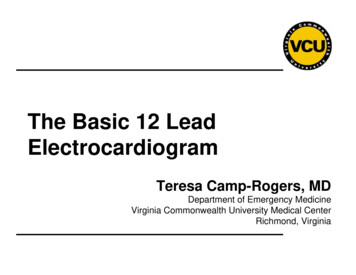
![[Page 1 – front cover] [Show cover CLEAN GET- AWAY 978-1 .](/img/13/9781984892973-6648.jpg)
